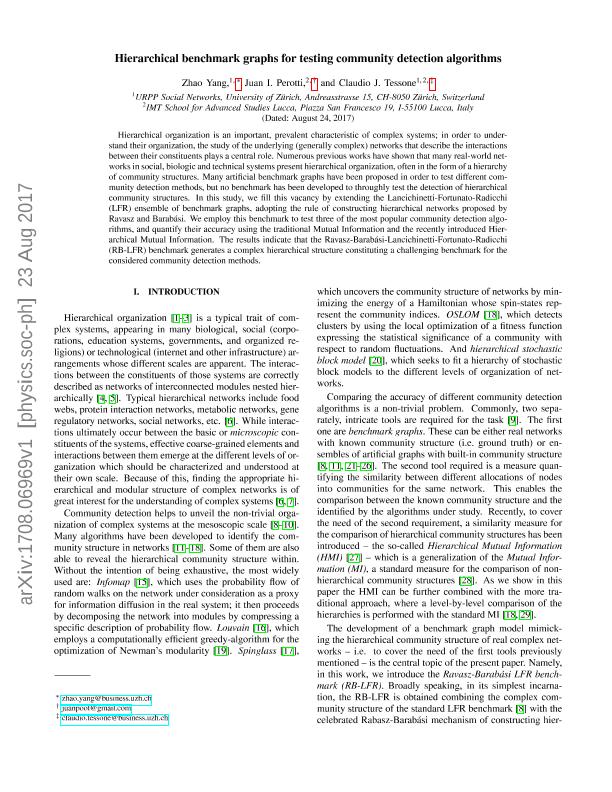Mostrar el registro sencillo del ítem
dc.contributor.author
Yang, Zhao
dc.contributor.author
Perotti, Juan Ignacio

dc.contributor.author
Tessone, Claudio J.
dc.date.available
2018-11-20T17:53:10Z
dc.date.issued
2017-11-14
dc.identifier.citation
Yang, Zhao; Perotti, Juan Ignacio; Tessone, Claudio J.; Hierarchical benchmark graphs for testing community detection algorithms; American Physical Society; Physical Review E; 96; 5; 14-11-2017; 52311-52311
dc.identifier.issn
2470-0053
dc.identifier.uri
http://hdl.handle.net/11336/64765
dc.description.abstract
Hierarchical organization is an important, prevalent characteristic of complex systems; to understand their organization, the study of the underlying (generally complex) networks that describe the interactions between their constituents plays a central role. Numerous previous works have shown that many real-world networks in social, biologic, and technical systems present hierarchical organization, often in the form of a hierarchy of community structures. Many artificial benchmark graphs have been proposed to test different community detection methods, but no benchmark has been developed to thoroughly test the detection of hierarchical community structures. In this study, we fill this vacancy by extending the Lancichinetti-Fortunato-Radicchi (LFR) ensemble of benchmark graphs, adopting the rule of constructing hierarchical networks proposed by Ravasz and Barabási. We employ this benchmark to test three of the most popular community detection algorithms and quantify their accuracy using the traditional mutual information and the recently introduced hierarchical mutual information. The results indicate that the Ravasz-Barabási-Lancichinetti-Fortunato-Radicchi (RB-LFR) benchmark generates a complex hierarchical structure constituting a challenging benchmark for the considered community detection methods.
dc.format
application/pdf
dc.language.iso
eng
dc.publisher
American Physical Society

dc.rights
info:eu-repo/semantics/openAccess
dc.rights.uri
https://creativecommons.org/licenses/by-nc-sa/2.5/ar/
dc.subject
Redes Complejas
dc.subject
Jerarquías
dc.subject
Detección de Comunidades
dc.subject.classification
Astronomía

dc.subject.classification
Ciencias Físicas

dc.subject.classification
CIENCIAS NATURALES Y EXACTAS

dc.title
Hierarchical benchmark graphs for testing community detection algorithms
dc.type
info:eu-repo/semantics/article
dc.type
info:ar-repo/semantics/artículo
dc.type
info:eu-repo/semantics/publishedVersion
dc.date.updated
2018-10-23T21:21:57Z
dc.identifier.eissn
2470-0045
dc.journal.volume
96
dc.journal.number
5
dc.journal.pagination
52311-52311
dc.journal.pais
Estados Unidos

dc.journal.ciudad
Maryland
dc.description.fil
Fil: Yang, Zhao. Universitat Zurich; Suiza
dc.description.fil
Fil: Perotti, Juan Ignacio. Consejo Nacional de Investigaciones Científicas y Técnicas. Centro Científico Tecnológico Conicet - Córdoba. Instituto de Física Enrique Gaviola. Universidad Nacional de Córdoba. Instituto de Física Enrique Gaviola; Argentina. Imt Institute For Advanced Studies Lucca; Italia
dc.description.fil
Fil: Tessone, Claudio J.. Imt Institute For Advanced Studies Lucca; Italia. Universitat Zurich; Suiza
dc.journal.title
Physical Review E
dc.relation.alternativeid
info:eu-repo/semantics/altIdentifier/url/https://journals.aps.org/pre/abstract/10.1103/PhysRevE.96.052311
dc.relation.alternativeid
info:eu-repo/semantics/altIdentifier/doi/https://dx.doi.org/10.1103/PhysRevE.96.052311
dc.relation.alternativeid
info:eu-repo/semantics/altIdentifier/url/https://arxiv.org/abs/1708.06969
Archivos asociados
